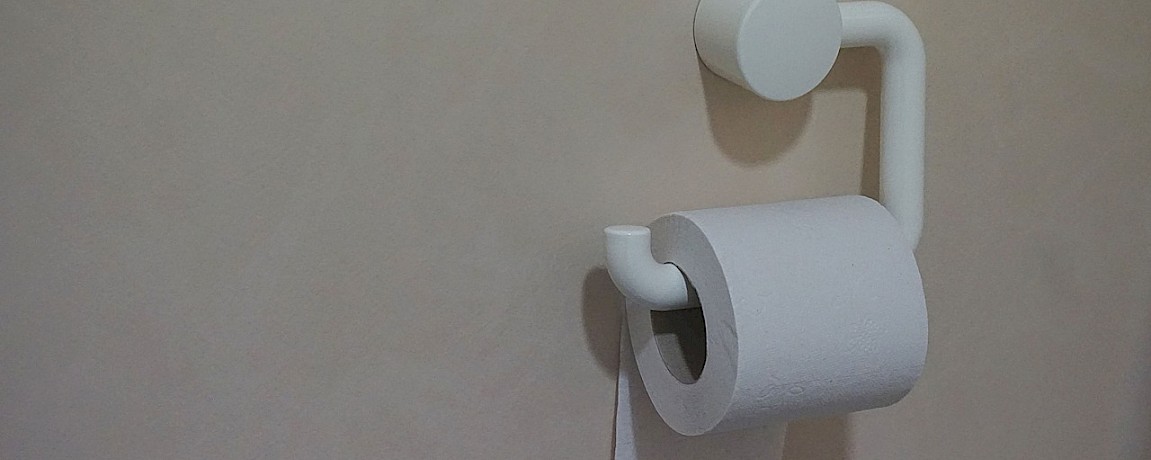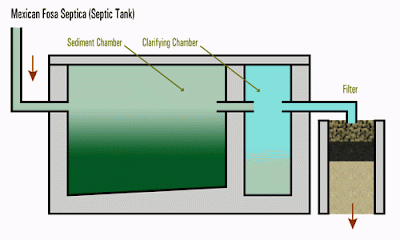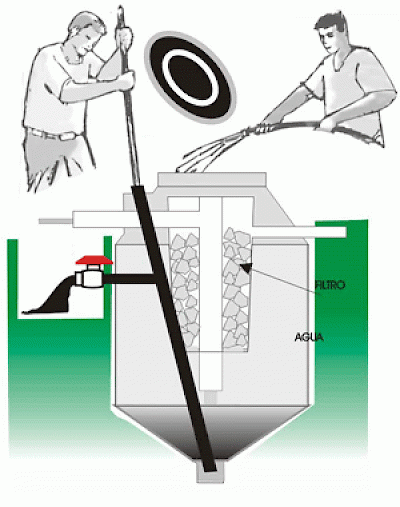Mexican Septic Systems
We promised to explain why you should not put paper in a Mexican toilet, and we’re not going to let you down. There are actually several answers to this question and the most puzzling of these is: you can put paper in a Mexican toilet! Yes, you can. The toilet will not spit the paper back out like a wrinkled dollar from a vending machine. The toilet police won’t show up at your door. And there will be no immediate ill effect from your indiscretion.
But it would be rude.
In many tourist destinations in Mexico, especially hotels, where modern sewage treatment is available, you are encouraged to flush your paper, just like in Gringolandia. The hotel management may even post little signs to let their Mexican guests know that they are expected to dispose of their papel confort down the toilet. They have to do this because Mexicans are trained from birth to be very polite.
But away from the tourist hangouts, and especially in private homes, you will encounter a small, covered, plastic or plastic-lined wastebasket near the toilet. If you see one, then be a polite guest and put your paper in there, not down the toilet.
To understand what etiquette has to do with how you dispose of toilet paper in Mexico, we need a basic understanding of sewer systems. If you are reading this from your home or office in Gringolandia, chances are that your toilet (and anything else that drains from your house) is connected to your city’s public sewer system. Everything you flush flows through large concrete pipes to an industrial processing plant where the solids are separated from the liquids. The liquids are filtered and treated with chemicals and the result is released back into the environment in the least offensive way possible where nature finishes the process using evaporation and rain. The solids are also treated and refined, resulting either in trash or fertilizer. This immense infrastructure is quite expensive to install, operate and maintain. It also consumes a lot of energy. These are your tax dollars at work.
Gringos who flush outside the city limits use a private septic tank, called a fosa septica (septic pit) or sumidero (drain) here in Mexico. In Gringolandia, a septic tank is usually made of a durable plastic and has two chambers, each with a pipe tee inside. The first is the sediment chamber, where the wastewater initially enters. User Plawerth explains the process neatly in his comment:
When waste enters the tank, the paper, poo, and any oils from bathing will float near the surface as a layer known as scum. Over time bacteria will consume nutrients in the scum, and it then settles on the bottom as dense sludge, which is basically inert compost.
When liquid enters the tank, an equal amount of liquid flows out the drain pipe. The tee with its long tube extending down below the surface prevents the floating scum from leaving the tank. The upper part of the tee allows methane and other gases to vent out, while preventing soap foam and lightweight scum above the water line from leaving the tank.
Some scum can still potentially pass, though, which is why there is almost always at least two chambers, and sometimes three chambers, each with a tee on the liquid outlet to restrict scum from leaving the chamber. Usually the first chamber contains most of the sludge and the second and third chambers contain little or no sludge.
If the tank is not cleaned of sludge often enough, eventually it will fill with sludge in all chambers, and then solids will start to leave the tank and plug up the leach field.
A filter on the final outlet will help keep solids that are overflowing out from a poorly maintained septic tank from reaching the drain field, but this needs to be a fine mesh plastic screen or a layer of sand, not just a pile of large loose rocks.
Unlike their northern neighbors, almost all Mexicans use a fosa septica, which is not much different than a Gringolandia septic tank. This technology is very old, so the process is the same. The only difference is the materials. Here in Mexico, many of the colonial houses and other buildings were constructed before the advent of plastics, so most fosa septica are built from plastered stone or concrete block. While plastic septic tanks have one or more manhole covers to permit inspection and cleaning, Mexican fosa septica are generally covered with a slab of concrete and sealed with plaster, like a tomb.
The important difference between a traditional, Mexican fosa septica and a plastic, Gringolandia septic tank is what happens when the clarified liquid is released back into the environment. In the plastic version, the liquid enters one or more perforated PVC pipes, which are buried in long trenches about four feet deep, filled halfway with gravel and covered with topsoil. This is called a drain field, and it’s where you want to plant your strawberries.
In the traditional, Mexican version, the liquid flows down into a filtro (filter), which is a concrete-lined pozo (well) filled with several inches of gravel on top, followed by several inches of charcoal in the middle, followed by a foot or two of sand at the bottom. Why use a filtro and not a drain field? One reason is because the filtro does not use plastics. Another is that this method takes up less space, which is a requirement in colonial urban zones.
But the filtro is the hurdle, so to speak, on the toilet paper trail. Even if much of the paper discarded in a Mexican toilet remains in the fosa septica’s sediment chamber, tiny bits do float past the clarifying chamber and into the filtro, so that over time a paper mache sludge builds up.
How much time does it take to clog a filtro? Nobody knows. It depends on how big the fosa septica and filtro are, how many people are using the toiliet and how much paper or other non-biodegradable stuff they’re flushing down there. It could take three years, or five, or ten. If you don’t flush any paper, it could take fifty or more.
As you probably know, all septic tank systems eventually fill up with sludge and non-biodegradable stuff and have to be pumped out. In Gringolandia, where most septic tanks are located under a lawn in the yard, this is not such a big deal: just dig for a few minutes, screw off the lid and pump away.
In Mexico, maintenance can be a bit more trouble. Many fosa septica are located under the patio, or they might be under the foundation of your house or even partially under your neighbor’s house, because many of these old colonial homes are the result of subdividing a larger mansion. Even when located in a back yard, the access is limited, which means the workers and their hoses will probably be coming through your front door. What’s more, most fosa septica are as old as the houses. Digging into them, like unearthing an ancient tomb, can be risky, leading to cracks or a complete collapse.
This is where famous Mexican thriftiness meets Mexican toilet training. No matter what their socio-economic station in life, Mexicans stretch their pesos and pretty much everything else. When the convenience of flushing paper down the toilet is at the expense of flushing pesos by cracking open a fosa septica, Mexicans would rather have the pesos. In this sense, it would be as rude to flush paper down your host’s toilet in Mexico as it would be to leave the door open on their refrigerator.
Most new homes and residential developments being built in Mexico today do use plastic septic tanks in their construction. When we were working on the design of our new home, we were offered the choice of a plastic septic tank or the traditional fosa septica. The plastic version, called a Septi-K, is billed as an environment-friendly version. It costs less than a fosa septica and has a cover you can remove to rinse the internal filter. The clarified liquids empty into a leach field or French drain. Every ten to 30 months, depending on use, you have to manually remove the lodo (uh... mud), which you can put in your yard as fertilizer or perhaps share with friends. And you can flush paper into it like a gringo.
Hmmm…
When we visit Gringolandia, we now feel uncomfortable putting paper in the toilet. Is it because sorting recyclables by hand is planet-friendly? Is it because it feels like throwing money down the toilet? Or is it just force of habit? Hard to say. In the end, we chose the traditional fosa septica for our new house.
So now you know what to do when you visit our bathroom and why you are doing it. Thanks to you, we may never have to service our fosa septica. At least in this one small way, we have assimilated into Mexican culture.










Comments
Stuffed Tiger 17 years ago
In Nepal it is too cold to bury it, resulting in flags from Western tourists. Not a pretty sight. The Nepalese use a bottle of water to clean themselves. As a hiker, I started using the Nepalese technique. It took some practice to get really clean with a single bottle of water, but it is quite doable. Warm water works best. Paper is only needed for drying when in a hurry. After awhile, I wondered how we can stand ourselves with poop smeared around our butts. We use deodorant for some odors but can't even smell others. I guess it's what you get used to. Once you get used to being clean, you feel dirty going back. Works well when there is no paper.
Reply
Irene 17 years ago
Oh, this is too funny!! Hello all! I was looking at some vacation sites in Yucatan area and came across this article. Couldn't pull myself away from the educational points as well as some of the interesting responses! I am a native born Mexican, from northern Mexico (Chihuahua) having been here in the US for about 40 yrs now. I can honestly tell you, it was a hard habit to break, BUT IT CAN BE DONE! :) However, I have to say my life has been very "gringo-ized" and even though I've broken the habit, I sometimes find myself wondering if I should "sometimes" use the aluminum pop-up lid can in our new home! We're on a 1+ acre property w/ 3.5 baths (kitch/laundry/etc) built in the 80's. And not being very saavy on septic systems, I sometimes wonder, should I? Anyway, it's not an upper class, lower class, Mexican/Greek/Philliipino, etc thing. It's what your parents taught you and since you respect your parents, you obey.
For David: Someone is obviously communicating w/ your employees instructing them on company procedures, hiring processes, etc. Couldn't they write a polite sign for your seasonal employees?
Thanks for a very interesting article!
Reply
Bradly G Boyer 18 years ago
Casai,
We are looking at a piece of property near Cuahtemoc, Mexico and when inquiring about the cost of putting in a septic system, we were told by a local about a system developed by the Mennonites that uses grey water for watering the land, etc. They said the cost was cheap. I am serious too! Sorry, no punchline...
Reply
CasaiYucateco 18 years ago
This sounds like the lead-in to a joke, but I can't figure out the punch line:
How is a Mennonite Septic System different from a "regular" septic system?
(seriously, I'd like to know) ;-)
Reply
Bradly G Boyer 18 years ago
are you familiar with the mennonite septic system developed and used in the cuauhtemoc, chihuahua region? it was recomended by a local as a solution.
Reply
Ed Palmer 18 years ago
NNNOOOOOOOO!!! I know old habits die hard but if you build a house and all is new you should never have to have the stinky waste basket! I keep a stainless flip top one in my office for visitors but let people in my house know that we have modern plumbing...(although the design is nothing new). Also for tree huggers (me too) that do not want to give up their TP, It is much better to let the paper degrade quickly in the tank than to put it in a solid waste dump.
Eddy
Reply
Elvira Jimenez 18 years ago
Hello everyone,
My husband and I recently bought a piece of land in The Yucatan Peninsula and are planning of building a house to retire in. We have been talking about building a septic system that would work for us, so all the ideas expressed here are helpful, a wealth of information! Mr. Ed Palmer, we may pay you a visit some day in the near future. Believe or not I have spent sleepless nights just thinking about it. We live in WA estate so we are familiar with septic systems but thanks to all of you we are better informed.
We were born in Mexico but have lived in the US for 30 years and we still put the toilet paper in the waste basket! We moved from CA to WA 20 years ago and bought a house with a septic tank-this was new to us so we never put the paper in the toilet believing that it would clog the tank, as the family grew we had to hook up to the sewer system, paid $7k in labor and permits and after an easement through our neighbors yard it was done. What a relief! But still put the toilet paper in the waste basket! I have a feeling that when we move to the Yucatan we still going to do the same and will politely ask our guests to do the same, that’s the beauty of owning your home?
Reply
Jose Villalobos 18 years ago
Dear Kim G.
Paper toilet is eaten by cellulose bacterias, as you know we excret organic materia and the principal bacterias are charcoal bacterias that are the ones who eat the organic materia, but is not the same for the cellulose bacterias take more time to digest and if you wants to have better efficent in the waste water including the toilet paper you most add a pills of cellulose bacterias into the septik tank.
You live a place that snows and the system can work but for the installation of this mexican fosa is a little different.
Thank you for your comments.
Jose
Reply
Kim G. 18 years ago
Well, this expanded version of the fosa septica article explains a lot. As I mentioned above, I grew up in a house with a septic tank, and we threw toilet paper into it, and never once in 18 years had to service it. But my dad's an engineer and designed (and built) it himself, so it was likely over-engineered. And it appears that the consensus of the engineers above is in line with my own experience. Paper is fine. But if your system is under-engineered, then it will clog sooner, and avoiding paper helps.
Anyway, thanks for a fascinating article and for starting an interesting debate. If I ever move to Mexico, the knowledge hereby gained will be valuable.
Regards,
Kim G
Boston, MA (where the ground is covered with ice)
Reply
David 18 years ago
Oh I understand that they are trying to be helpful. And I don't consider them unclean or anything. I used to live in El Paso, TX, and some of my best friends and even my sister are Mexican.
We do have bilingual workers who have tried to explain this to them in the past. The issue is that every other season, we have some workers go home and new workers show up, so the problem starts anew.
Thank you so much for the reply. I will try to put up the sign with your translation in a few places. I might even put a sign on the trash can that says, "No Toilet Paper" or the translation thereof. I will go ahead and put the oversized trash bag in the can just in case.
Thank you again.
Reply
CasiYucateco 18 years ago
David,
They are actually trying to help you out. Not knowing that it's done differently in the USA, they don't want to block up your pipes and cause problems. So, while it seems annoying or unclean to us, it means they are trying to do the right thing by you.
How about:
"Ponga el papel usado en el sanitario" (Put used paper into the toilet)
You might add:
"No causará problemas con la tuberia / plomeria" (It won't cause problems with the pipes / plumbing)
You could always have someone explain that there is no problem with putting toilet paper into the toilet in the USA because the pipes are bigger. That's a common belief in Mexico - the paper will clog the pipes. Are there any bilingual employees or friends of theirs? How do you explain what other work must be done by the employees?
As a last resort, simply line the trash can with oversized plastic bags (so there's plenty of clean plastic on the outside) and close up the bags with the contents inside.
(As a side note, you may think this is solely a problem with unskilled or uneducated workers, but we have many programmers in our office from various parts of the world. We're having a problem with this type of situation in our office bathrooms: http://www.healthline.com/blogs/exercise_fitness/2007/01/more-fun-squatting.html Footprints on the seat.)
Reply
« Back (50 to 61 comments)Next »